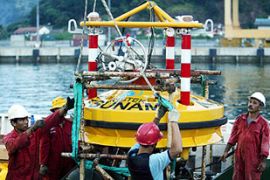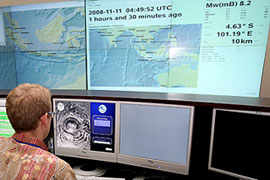Indian Ocean tsunami drill held
UN-backed exercise tests warning systems and overall preparedness across 18 nations.

|
“All depends how quickly the information is disseminated to a local government level, the authorities and finally to those peoples who are living in the areas under threat” Horst Letz, |
In Indonesia’s Aceh province, the area worst-hit in the 2004 disaster, sirens wailed and mosque loudspeakers ordering residents to seek safety.
In a statement the UN said the drill was the first comprehensive test and evaluation of the warning system.
It said the exercise had been designed to highlight faults and identify areas for improvement.
“All depends how quickly the information is disseminated to a local government level, the authorities and finally to those peoples who are living in the areas under threat so they can take action,” seismologist Horst Letz, the test’s technical advisor, said on Wednesday.
‘Better prepared’
The simulated tsunami would spread in real-time across the entire Indian Ocean, taking about 12 hours to travel from Indonesia to the coast of South Africa.
 |
| Experts say early tsunami warnings could help lower the number of deaths [EPA] |
Australia although not affected by the 2004 disaster, is playing a role in the regional system to improve response and warning times as well as international coordination.
Ray Canterford, a senior tsunami warning official at Australia’s Bureau of Meteorology, said Wednesday’s drill will test how efficiently messages are sent between those countries.
He said the exercise would involve different areas going on different levels of alert, including dummy warnings sent by telegram, fax and e-mail to participating countries.
“It’s a real-time event. We believe that all or most of the countries in the Indian Ocean are a lot better prepared now than they were in 2004,” he added.
However, the effectiveness of the alarm system has been questioned by some experts who say that in some cases the time difference between an earthquake and the resulting tsunami hitting an area would be very short – for example in Indonesia which is very close to active fault lines.
Tsunami waves can travel at speeds of 800-1,000 kmh.